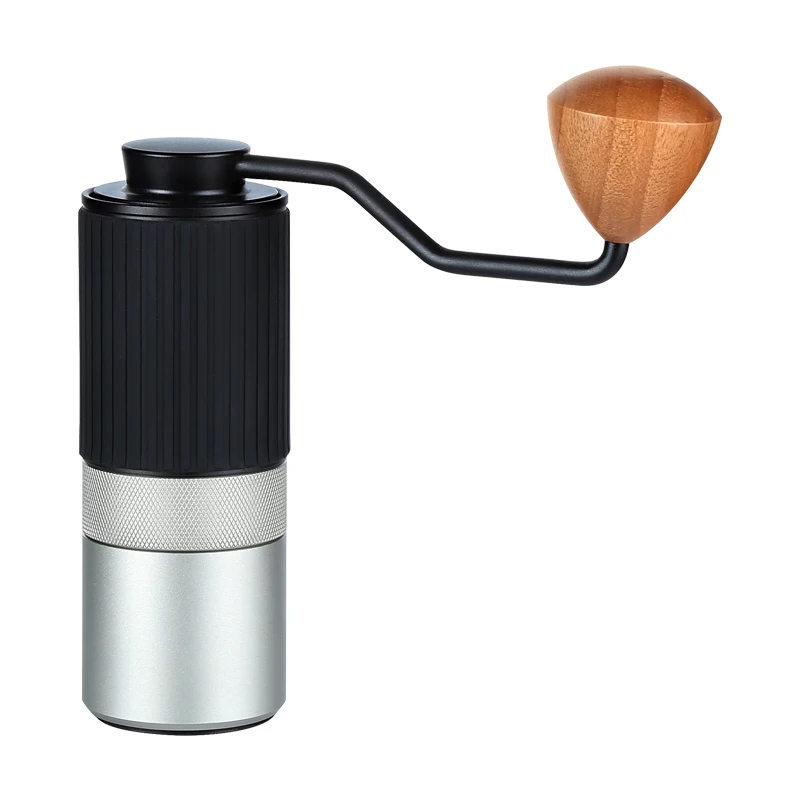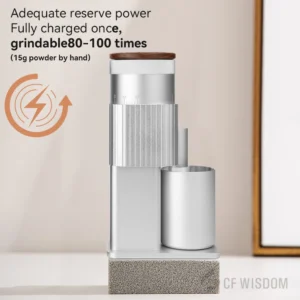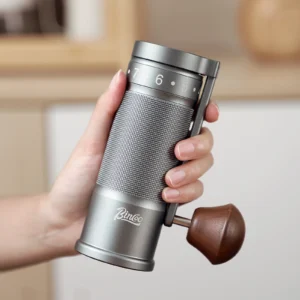There’s something deeply satisfying about manually grinding coffee beans—the aroma that rises with each turn, the control over your grind size, and the connection to the coffee-making process. Yet for many coffee enthusiasts, this rewarding ritual comes with an unwelcome companion: wrist pain and discomfort. Whether you’ve experienced a dull ache after preparing your morning brew or a sharp twinge that made you pause mid-grind, you’re not alone.
Manual coffee grinding can put significant strain on your wrists, particularly when done frequently or with improper technique. The repetitive rotational movement, combined with resistance from the beans and sometimes awkward grinder designs, creates a perfect storm for discomfort. The good news? With the right approach, equipment, and self-care routine, you can continue enjoying the satisfaction of hand-grinding without the pain.
In this comprehensive guide, we’ll explore why wrist strain occurs, how to recognize the warning signs, and most importantly, practical strategies to prevent and alleviate discomfort. At Savor Suite, we believe that precision grinding settings for espresso shouldn’t come at the cost of physical comfort—let’s discover how to beat the grind while enjoying your coffee ritual to the fullest.
Why Manual Coffee Grinding Causes Wrist Strain: Understanding the Mechanics
The discomfort you feel after grinding coffee beans manually isn’t just in your head—it’s rooted in biomechanics. When you turn a manual grinder handle, your wrist performs a complex combination of movements including rotation, flexion, and extension. These repetitive motions put stress on the small tendons and ligaments running through the narrow tunnel of your wrist.
Several factors contribute to this strain:
Repetitive Motion Stress: The circular motion required to operate a manual grinder forces your wrist to work in ways it wasn’t designed to repeat dozens or hundreds of times in quick succession.
Resistance from Beans and Burrs: Particularly when grinding for espresso, the resistance created as beans pass through the burrs requires significant force, which must be generated by your wrist, hand, and forearm muscles.
Awkward Positioning: Many grinders force users into non-neutral wrist positions, especially when stabilizing the grinder body while turning the handle.
Grinder Design Limitations: The ergonomics of manual versus automatic grinder settings significantly impact the strain on your body. Short handles provide less leverage, requiring more force from small wrist muscles rather than larger arm and shoulder muscles.
The quality of your grinder matters tremendously. Dull or poor-quality burrs in some hand burr grinders create additional resistance, forcing you to work harder for the same result. This extra effort translates directly to increased strain on your wrists.
For people with pre-existing conditions like carpal tunnel syndrome, tendonitis, or arthritis, manual grinding can exacerbate symptoms by irritating already sensitive tissues. Even for those without prior issues, the repetitive stress can gradually lead to inflammation and discomfort over time.
Identifying Wrist Strain Symptoms: When Your Body Signals a Problem
Recognizing the early warning signs of wrist strain can help you address issues before they become serious problems. Your body typically provides clear signals when the grinding motion is causing damage. Here are key symptoms to watch for:
Mild Discomfort and Aching: A dull ache in your wrist, hand, or forearm during or after grinding that goes away with rest
Sharp or Shooting Pain: Sudden pain, especially when turning the handle or when your wrist is at certain angles
Numbness or Tingling: “Pins and needles” sensation in your fingers, palm, or wrist—often a sign of nerve compression
Reduced Grip Strength: Difficulty holding objects firmly or weakness when trying to turn the grinder handle
Stiffness and Limited Motion: Decreased range of motion in your wrist or difficulty rotating, flexing, or extending your hand
Visible Swelling: Puffiness around the wrist joint, potentially warm to the touch
Morning Stiffness: Waking up with stiff, sore wrists after a day of manual grinding
Pay particular attention to how quickly your symptoms resolve. Temporary discomfort that fades within minutes after grinding is likely normal muscle fatigue. However, pain or stiffness lasting hours or worsening over days suggests a developing issue that needs addressing.
The frequency of your grinding routine matters too. Daily grinders might experience gradual symptom onset, while weekend coffee enthusiasts might notice problems mainly after longer grinding sessions. Users who value the ergonomic features of coffee grinders often report significantly less discomfort even with frequent use.
Perfecting Your Technique: Ergonomic Grinding Methods
One of the most effective ways to prevent wrist strain is improving your grinding technique. Small adjustments to your posture and method can dramatically reduce the stress on your joints and tendons.
Optimal Body Position
Stand or sit with good posture: Keep your back straight and shoulders relaxed.
Position the grinder at elbow height: Place your grinder on a counter or table that allows your elbow to maintain a 90-degree angle while grinding.
Face the grinder directly: Avoid twisting your body or reaching across yourself to grind.
Proper Wrist Alignment
Maintain a neutral wrist position: Try to keep your wrist aligned with your forearm rather than bent at extreme angles.
Use your whole arm: Generate power from your shoulder and elbow rather than isolating movement to just your wrist.
Switch hands periodically: Alternate between your dominant and non-dominant hand to distribute the workload.
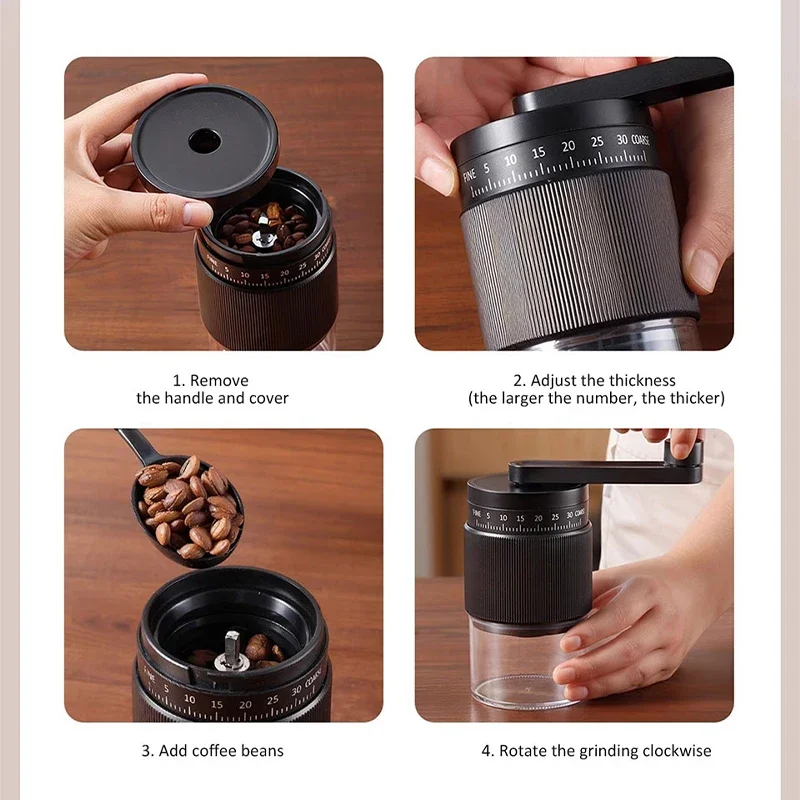
Grip and Stabilization Techniques
Hold the grinder body firmly: Use your non-grinding hand to stabilize the grinder body firmly against the counter or between your knees when sitting.
Use a relaxed but secure grip: Avoid death-gripping the handle, which increases tension in forearm muscles.
Consider comfortable manual coffee grinder handles: Grinders with larger, ergonomically designed handles allow for a more relaxed grip.
Pacing and Rhythm
Grind at a moderate, consistent pace: Resist the temptation to grind as quickly as possible.
Take micro-breaks: Pause briefly every 15-20 seconds to relax your grip and shake out your hand.
Divide larger batches: For brewing methods requiring more coffee, consider dividing your grinding into smaller sessions with brief rests between.
By implementing these technique improvements, many coffee enthusiasts find they can continue enjoying the manual grinding experience with significantly reduced discomfort. Remember that proper technique remains important regardless of how premium your grinder might be.
Choosing the Right Manual Grinder: Design Features That Protect Your Wrists
The design of your grinder plays a crucial role in preventing wrist strain. When shopping for a new manual grinder or evaluating your current one, these features can make a significant difference:
Handle Design
- Length: Longer handles (3-4 inches or more) provide better leverage, requiring less force to turn
- Shape: Ergonomic knobs that fit comfortably in your palm reduce pressure points
- Material: Smooth, non-slip surfaces allow a relaxed grip while maintaining control
Burr Quality and Efficiency
- Sharpness: Premium burrs cut beans more efficiently, reducing resistance
- Material: Ceramic and high-quality steel burrs typically require less force than cheaper alternatives
- Alignment: Precisely aligned burrs move more smoothly, decreasing the force needed
Stability Features
| Feature | Benefit |
|---|---|
| Wide base | Prevents tipping, reducing need for stabilization force |
| Non-slip bottom | Keeps grinder in place without excessive downward pressure |
| Body design | Ergonomic shapes that fit comfortably in hand while stabilizing |
Our stainless steel manual coffee grinders typically offer excellent stability combined with smooth-operating burrs, creating less strain during use. When evaluating grinders, consider how they feel during a complete grinding session, not just for the first few turns.
The right grinder should allow your wrist to remain in a neutral position throughout most of the grinding motion. This often means selecting a grinder with an appropriate height for your body proportions and a comfortable circumference for your hand size.
Remember that even the most ergonomic grinder still requires proper technique to prevent strain. The combination of quality equipment and good form creates the ideal conditions for comfortable grinding.
Essential Preventive Stretches and Warm-ups for Coffee Grinders
Just as athletes warm up before exercise, coffee enthusiasts can benefit from preparing their wrists before grinding. A simple pre-grinding routine takes just minutes but can significantly reduce strain and discomfort.
Quick Pre-Grinding Warm-Up (30 seconds)
- Wrist circles: Rotate both wrists clockwise 5 times, then counterclockwise 5 times
- Finger fans: Spread fingers wide, then make a fist, repeat 5 times
- Gentle stretches: Extend arm, gently pull fingers back toward body for 5 seconds
Daily Wrist Maintenance Stretches (5 minutes)
Prayer stretch: Place palms together at chest height, slowly lower wrists while keeping palms pressed together until you feel a gentle stretch in forearms, hold 15-30 seconds
Fist to fan: Make a tight fist, hold for 5 seconds, then spread fingers as wide as possible, hold for 5 seconds, repeat 5 times
Forearm stretch: Extend one arm straight out with palm up, use other hand to gently pull fingers down and back, hold 15-30 seconds, repeat with palm down
Cross-body wrist stretch: Extend arm across body at chest height, use opposite hand to gently pull extended hand toward body, feeling stretch on outer wrist, hold 15-30 seconds
These stretches specifically target the muscles and tendons used during grinding. Incorporating them into your coffee routine can help maintain flexibility and reduce strain. Our precision manual grinders work best when paired with good physical preparation to ensure comfort during use.
Make these stretches part of your daily routine—not just before grinding but throughout your day, especially if you work at a computer or perform other repetitive hand movements.
Strength Training: Building Resilient Wrists for Better Grinding
Stronger wrists and forearms can withstand the rigors of manual grinding with less strain. These simple exercises require minimal equipment and can be easily incorporated into your routine:
Grip Strengthening
Stress ball squeezes: Squeeze a soft stress ball or tennis ball for 5 seconds, then release. Perform 10-15 repetitions, 2-3 sets daily.
Finger resistance: Place a rubber band around your fingers, then spread them against the resistance. Hold for 3 seconds, repeat 10 times.
Towel wringing: Soak a small towel in water, then twist and wring it out completely. Repeat 3-5 times in each direction.
Wrist Stability Exercises
Wrist curls: Sitting with forearm on knee or table edge and hand hanging over edge, hold a light weight (1-3 lbs) and slowly curl wrist upward, then lower. Perform 10-15 repetitions in each direction.
Radial/ulnar deviation: With forearm supported and a light weight in hand, slowly move hand side to side (like a windshield wiper). Perform 10 repetitions.
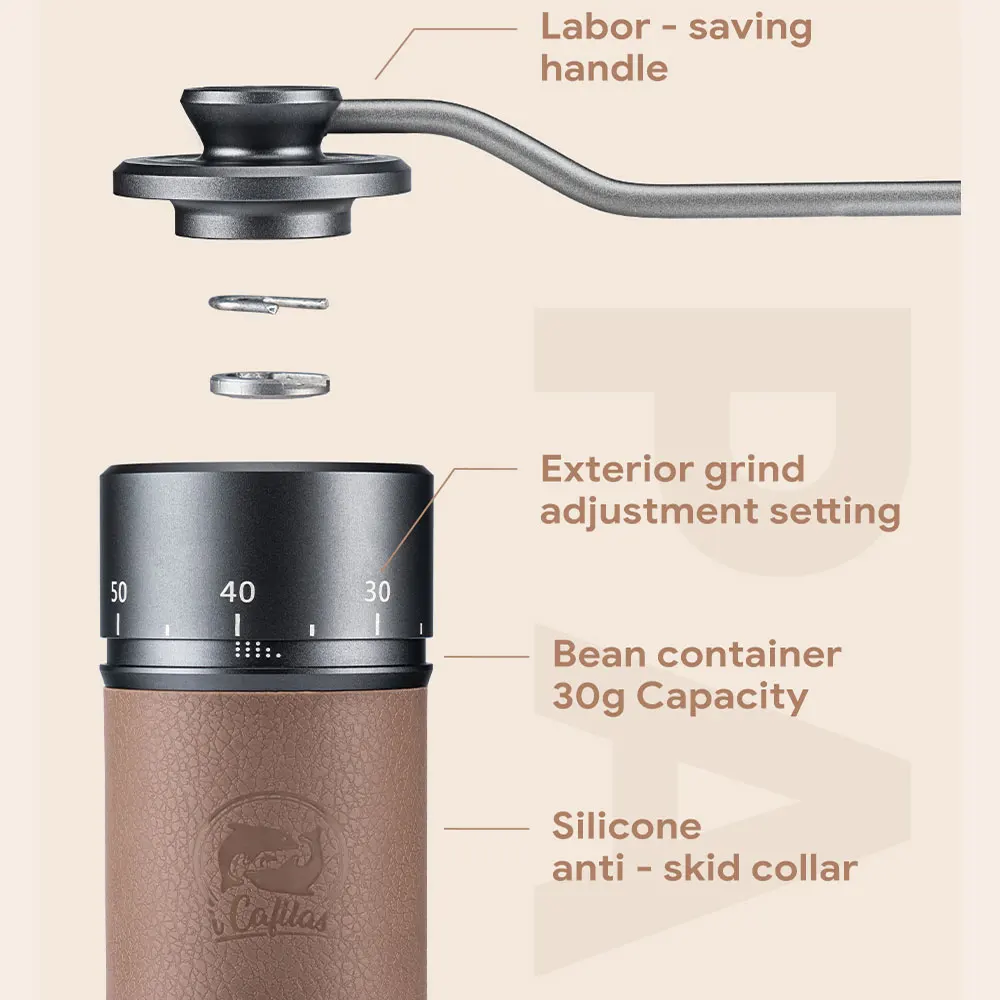
Supporting Muscle Development
Forearm pronation/supination: Holding a light weight or hammer, rotate your forearm so palm faces up, then down. Perform 10 repetitions in each direction.
Wrist extension against wall: In push-up position against wall, lean forward to feel stretch in forearms, hold 15 seconds, repeat 3 times.
These exercises specifically target the muscles used when grinding coffee. Start with light weights and increase gradually as strength improves. Consistency matters more than intensity—performing these exercises 2-3 times weekly can significantly improve your grinding endurance and comfort.
Understanding the ultimate espresso grind size chart will help you anticipate how much effort different grind settings require, allowing you to prepare accordingly. Finer grinds typically demand more force and therefore benefit more from strengthened wrists.
Immediate Relief: Treating Wrist Pain After Grinding
Despite your best preventive efforts, you might occasionally experience wrist discomfort after grinding. Here’s how to address pain when it occurs:
RICE Method Implementation
Rest: Give your wrist a break from grinding and other strenuous activities for 24-48 hours.
Ice: Apply an ice pack wrapped in a thin towel for 15-20 minutes every 2-3 hours to reduce inflammation.
Compression: Use an elastic bandage or wrist sleeve to provide gentle compression, which helps control swelling.
Elevation: When possible, keep your wrist elevated above heart level to minimize swelling.
Self-Massage Techniques
Palm circular friction: With thumb of opposite hand, make small circular motions across palm and base of thumb for 1-2 minutes.
Forearm strokes: Using light to moderate pressure, stroke from wrist to elbow along forearm muscles for 30-60 seconds per side.
Cross-friction massage: For specific tender points, use thumb to apply gentle pressure across (perpendicular to) the affected tendon for 30 seconds.
Supportive Measures
Over-the-counter pain relievers: Non-steroidal anti-inflammatory drugs like ibuprofen can help reduce pain and inflammation when used as directed.
Wrist supports: A simple wrist brace worn at night can promote healing by preventing awkward positions during sleep.
Heat therapy: After the initial 48 hours, alternating between ice and heat (warm, not hot) can promote healing by increasing blood flow.
If you’re currently recovering from wrist strain, consider temporarily switching to all-metal hand grinders with excellent stability and smooth operation to reduce additional strain while healing.
Most mild to moderate wrist strain should begin improving within a few days of implementing these measures. If pain persists or worsens despite self-care efforts, it may be time to consult a healthcare professional.
When to See a Professional: Red Flags for Serious Wrist Issues
While many cases of grinding-related discomfort resolve with self-care, some situations warrant professional medical attention. Be alert to these warning signs:
Warning Signs Requiring Medical Attention
- Persistent pain lasting more than 1-2 weeks despite rest and self-treatment
- Numbness or tingling that doesn’t resolve within a few hours after grinding
- Visible swelling that doesn’t improve after 48 hours of RICE treatment
- Reduced grip strength that interferes with daily activities
- Clicking or popping sounds accompanied by pain when moving your wrist
- Night pain that disturbs sleep or wakes you from sleep
- Inability to perform simple tasks like turning doorknobs or opening jars
Appropriate Healthcare Providers
For wrist issues, consider consulting:
* Primary care physician (for initial assessment)
* Orthopedic specialist (for musculoskeletal issues)
* Physical therapist (for rehabilitation exercises)
* Occupational therapist (for modifications to daily activities)
Your healthcare provider may recommend diagnostic tests such as X-rays to rule out fractures or MRIs to assess soft tissue damage. They might also evaluate you for common conditions like carpal tunnel syndrome or tendonitis, which can be aggravated by manual grinding.
Professional treatment might include prescribed anti-inflammatories, specialized stretching regimens, steroid injections for severe inflammation, or in rare cases, surgical intervention for structural issues.
Don’t hesitate to seek medical advice if your symptoms are severe or persistent—early intervention typically leads to faster and more complete recovery for wrist injuries.
Alternative Solutions: When Manual Grinding Isn’t Working for You
Sometimes, despite best efforts with technique and equipment, manual grinding may need to be temporarily or permanently modified. Here are practical alternatives that still preserve coffee quality:
Electric Grinder Options
Consider high-quality electric burr grinders that maintain precision grinding without physical strain. Modern compact models offer excellent grind consistency while requiring minimal counter space.
Adaptive Manual Grinding
- Buddy system: Share grinding duties with household members
- Batch grinding: Process several days’ worth when feeling good, store in airtight containers
- Grinding supports: Use countertop clamps or vises to hold grinder body (with protection to prevent damage)
Pre-Ground Specialty Coffee
For temporary relief periods, many specialty roasters offer freshly ground coffee:
* Request grinding immediately before shipping
* Store in small, airtight containers to maintain freshness
* Consider slightly coarser grinds which tend to preserve flavor longer than fine grinds
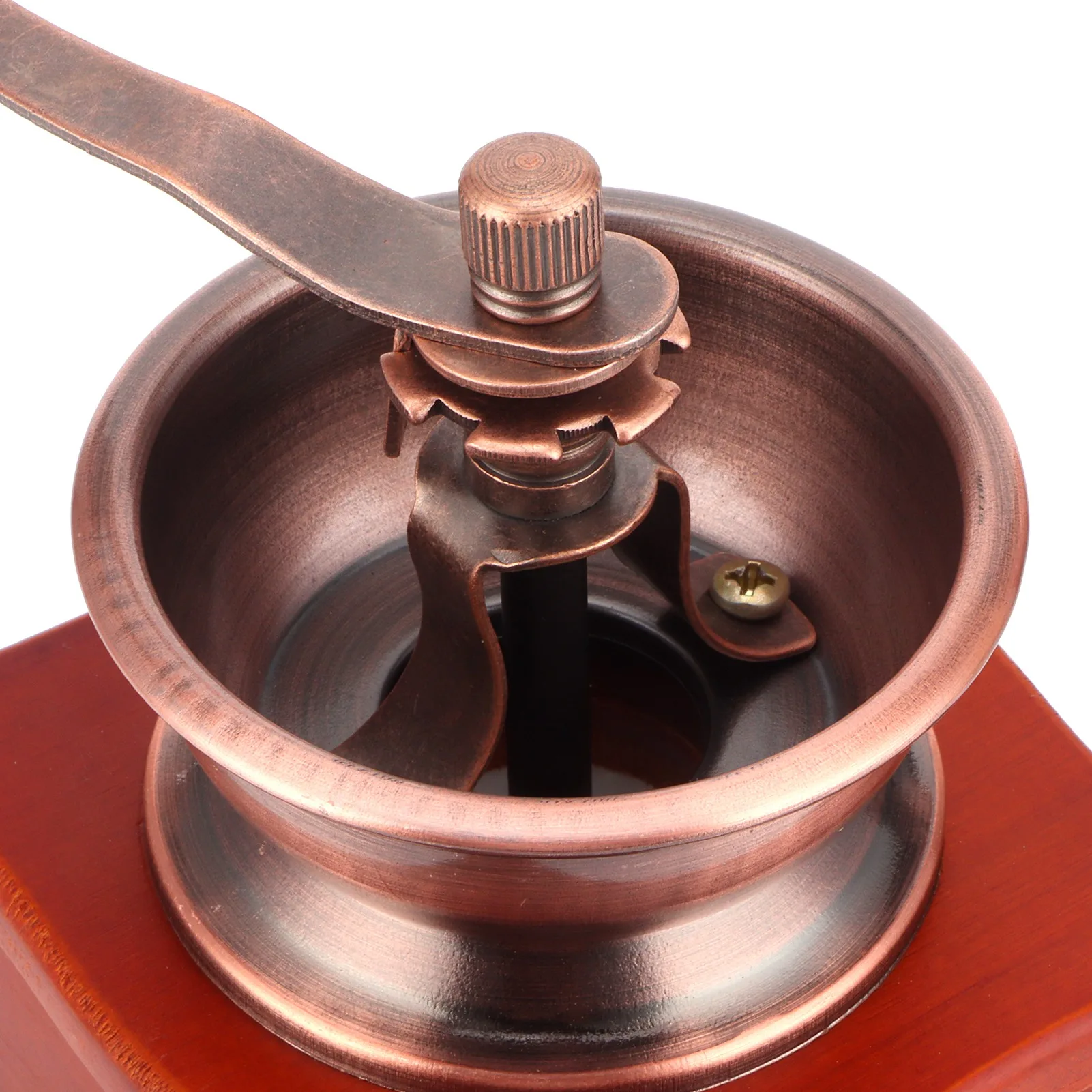
Balancing Freshness and Comfort
While freshly ground coffee offers peak flavor, using pre-ground coffee for a short period is vastly preferable to developing a chronic wrist condition. When purchasing pre-ground coffee, look for:
* Roasters who grind to order
* Packaging with one-way valves to release CO2 without letting oxygen in
* Smaller quantities for more frequent replacement
Fine Adjustment Hand Grinder, Precision Manual Grinder, Travel Coffee Grinder
Price range: $185.11 through $494.63 Select options This product has multiple variants. The options may be chosen on the product pageHand Burr Grinder, Hand Crank Coffee Grinder, Manual Espresso Grinder, Portable Coffee Grinder
Price range: $262.72 through $300.22 Select options This product has multiple variants. The options may be chosen on the product pageManual Burr Mill, Manual Coffee Grinder Stainless Steel, Manual Coffee Mill Grinder, Mechanical Coffee Grinder
Price range: $127.26 through $130.32 Select options This product has multiple variants. The options may be chosen on the product pageHand Burr Grinder, Manual Coffee Grinder Stainless Steel, Precision Manual Grinder
Price range: $183.64 through $187.52 Select options This product has multiple variants. The options may be chosen on the product page
Understanding the correct grind setting for espresso helps you communicate your needs precisely if you’re having someone else grind your coffee temporarily. This ensures you’ll still achieve excellent extraction despite the change in routine.
Conclusion: Balancing the Art of Manual Grinding with Wrist Health
The ritual of manually grinding coffee beans connects us deeply to the brewing process, offering unparalleled freshness and control. With the right technique, equipment, and self-care practices, this rewarding experience doesn’t have to come with pain or discomfort.
Remember that prevention is always easier than treatment—implementing proper ergonomic techniques, choosing well-designed grinders, and maintaining wrist strength and flexibility will protect you from most grinding-related strain. When discomfort does occur, responding promptly with rest and appropriate care can prevent minor issues from becoming chronic problems.
Your coffee ritual should be a source of pleasure rather than pain. By approaching manual grinding mindfully, listening to your body’s signals, and making adjustments when needed, you can continue enjoying the satisfying process of preparing truly fresh coffee for years to come. The perfect grind is one that’s both precise and comfortable—because great coffee should be good for both body and soul.

